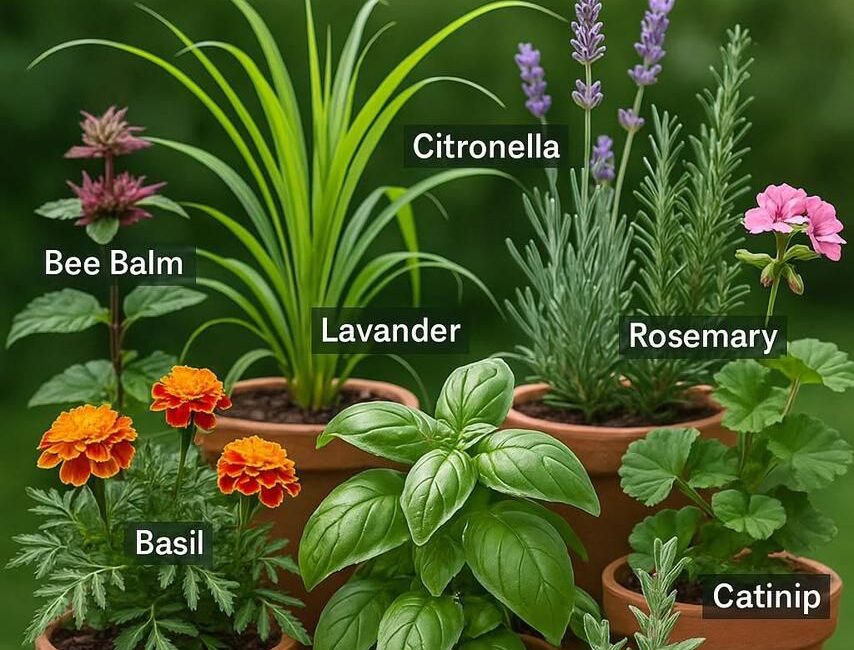Mosquitoes are more than just annoying insects—they are carriers of serious diseases such as West Nile virus, dengue, Zika, and malaria. While chemical repellents can be effective, they often come with environmental and health concerns. Fortunately, nature provides powerful, fragrant alternatives in the form of mosquito-repellent plants.
These plants release essential oils and aromatic compounds that interfere with mosquitoes’ ability to locate their prey. By strategically growing or placing these plants in your garden, patio, or even indoors, you can create a more pleasant, bite-free environment without relying on toxic sprays or synthetic repellents.
In this comprehensive guide, we explore 9 proven mosquito-repelling plants—their unique properties, how they work, and tips for growing and using them effectively.
1. 🌸 Bee Balm (Monarda didyma)
Other names: Bergamot, Oswego Tea
Key Repellent Compound: Thymol, citronellol
Why It Works:
Bee Balm emits a strong, citrusy-mint aroma that mosquitoes dislike. The volatile oils found in its leaves and flowers help mask the human scent, making it harder for mosquitoes to find you. It also attracts pollinators like bees, hummingbirds, and butterflies, supporting a healthy garden ecosystem.
Additional Benefits:
- Adds bold color to garden beds with red, purple, pink, or white flowers
- Used in herbal teas and traditional medicine for digestion and colds
Growing Tips:
- Hardy in USDA Zones 3–9
- Requires full sun and well-drained soil
- Deadhead to encourage continued blooming
- Can spread quickly—divide clumps every few years
How to Use:
- Plant near patios, decks, or seating areas
- Crush fresh leaves and rub on exposed skin (test first for sensitivity)
- Dry flowers and make a natural potpourri
2. 🌿 Citronella (Cymbopogon nardus or Cymbopogon winterianus)
Key Repellent Compound: Citronellal, citronellol, geraniol
Why It Works:
Citronella is perhaps the most famous mosquito-repelling plant, used in candles, sprays, and topical repellents. The plant’s intense lemony fragrance overwhelms mosquitoes’ sensory receptors, making it difficult for them to detect human hosts.
Additional Benefits:
- Natural air freshener
- Grown as ornamental grass in tropical landscaping
Growing Tips:
- Prefers warm, humid climates (Zones 9–11)
- In cooler climates, grow in pots and bring indoors during winter
- Needs full sun and moist, well-drained soil
- Prune regularly to encourage growth
How to Use:
- Crush leaves and apply oil directly to skin (diluted)
- Use fresh leaves in citronella-infused DIY sprays
- Plant along pathways or garden borders
3. 💜 Lavender (Lavandula angustifolia)
Key Repellent Compound: Linalool, camphor
Why It Works:
Lavender’s signature calming scent is pleasant to humans but repulsive to mosquitoes, flies, moths, and even fleas. Its essential oils disrupt the insect’s nervous system and deter them from entering the area.
Additional Benefits:
- Reduces stress and anxiety
- Attracts pollinators and beneficial insects
- Used in skincare, aromatherapy, and culinary dishes
Growing Tips:
- Hardy in Zones 5–9
- Requires full sun and sandy, well-drained soil
- Do not overwater; lavender hates soggy roots
- Prune after flowering to keep it compact
How to Use:
- Rub crushed flowers directly onto skin
- Hang dried bunches around the home or patio
- Distill into homemade lavender oil or spray
4. 🌿 Rosemary (Rosmarinus officinalis)
Key Repellent Compound: Cineole, camphor, rosmarinic acid
Why It Works:
Rosemary contains potent essential oils that repel mosquitoes and other insects, especially when burned. The smoke from burning rosemary sprigs is particularly effective at keeping bugs away during outdoor gatherings.
Additional Benefits:
- Aromatic herb used in cooking
- Acts as a natural insecticide for vegetable gardens
- Promotes memory and focus
Growing Tips:
- Hardy in Zones 7–10 (grow indoors in colder climates)
- Needs full sun and well-drained soil
- Can be grown in pots or as a low hedge
- Trim often to encourage bushy growth
How to Use:
- Burn dried rosemary in a fire pit or grill
- Rub fresh sprigs onto skin or clothing
- Infuse in olive oil to make a mosquito-repellent balm
5. 🌿 Basil (Ocimum basilicum)
Key Repellent Compound: Eugenol, citronellol, linalool
Why It Works:
Basil emits a strong scent that confuses mosquitoes’ sense of smell. Several varieties—particularly lemon basil and cinnamon basil—are highly effective at repelling mosquitoes thanks to their high concentration of essential oils.
Additional Benefits:
- Tasty and aromatic herb for culinary use
- Anti-inflammatory and antioxidant properties
- Also deters houseflies
Growing Tips:
- Needs full sun and frequent watering
- Pinch off flowers to promote leaf growth
- Grows well in containers or garden beds
- Harvest regularly to prevent bolting
How to Use:
- Crush leaves and rub on skin as a quick repellant
- Add fresh basil to window sills or patios
- Use in herbal sprays with witch hazel or alcohol base
6. 🐱 Catnip (Nepeta cataria)
Key Repellent Compound: Nepetalactone
Why It Works:
Surprisingly, catnip is more effective than DEET (a synthetic chemical used in bug sprays) at repelling mosquitoes in some studies. The active compound nepetalactone is a powerful mosquito deterrent.
Additional Benefits:
- Loved by cats for its euphoric effects
- Easy to grow and drought-tolerant
- Can also repel cockroaches and flies
Growing Tips:
- Hardy in Zones 3–9
- Prefers full sun and well-drained soil
- Self-seeds easily, so trim to prevent overgrowth
- Tolerates poor soil and dry conditions
How to Use:
- Rub fresh leaves on clothing or skin
- Use dried catnip in homemade insect-repelling sachets
- Crush and boil to make a natural mosquito spray
7. 🌼 Marigold (Tagetes spp.)
Key Repellent Compound: Pyrethrum
Why It Works:
Marigolds contain pyrethrum, a natural insecticide used in many commercial repellents. The pungent smell keeps mosquitoes, whiteflies, aphids, and nematodes at bay.
Additional Benefits:
- Bright, cheerful blooms that add color to gardens
- Protect vegetable crops when used as companion plants
- Easy to grow and maintain
Growing Tips:
- Full sun, moist well-drained soil
- Bloom from spring through fall
- Deadhead regularly to encourage more blooms
- Can be planted in garden beds, borders, or containers
How to Use:
- Plant around patios, doorways, and windows
- Crush petals and rub on skin for short-term protection
- Use in companion planting to protect vegetables
8. 🌱 Mint (Mentha spp.)
Key Repellent Compound: Menthol, pulegone
Why It Works:
Mint produces a sharp, mentholated aroma that mosquitoes—and even ants and mice—avoid. While pleasant for humans, mint’s powerful scent overwhelms insect senses.
Additional Benefits:
- Supports digestion and respiratory health
- Freshens breath
- Easy to grow (sometimes too easy—can become invasive)
Growing Tips:
- Hardy in Zones 3–11
- Grows best in partial shade and moist soil
- Best kept in containers to prevent spreading
- Cut regularly to control size
How to Use:
- Rub fresh leaves on skin or place near windows
- Use in footbaths or herbal sprays
- Dry and crush leaves into sachets
9. 🌺 Geranium (Pelargonium spp.)
Key Repellent Compound: Geraniol, citronellol
Why It Works:
Scented geraniums—particularly lemon-scented varieties—are effective mosquito deterrents. Their strong, citrus-like aroma mimics citronella, confusing and repelling mosquitoes.
Additional Benefits:
- Attractive ornamental plant with fragrant leaves
- Can repel ticks and other biting insects
- Adds beauty to porches, balconies, and gardens
Growing Tips:
- Grow in full sun to partial shade
- Ideal for containers and hanging baskets
- Water moderately and deadhead spent blooms
- Bring indoors before frost in colder climates
How to Use:
- Place near outdoor seating areas
- Crush leaves and apply oil to pulse points
- Use in floral arrangements for dual beauty and function
ChatGPT a dit :
🌱 Conclusion: A Natural, Eco-Friendly Mosquito Barrier
Incorporating mosquito-repellent plants into your garden or home offers dual benefits: natural pest control and enhanced aesthetic appeal. Many of these plants can be easily grown in containers, hanging baskets, or garden beds, making them accessible for both small and large spaces. By choosing a variety of these plants, you can create a harmonious outdoor environment where both you and beneficial pollinators thrive.
Next time you plan to host an outdoor gathering or enjoy your garden, consider planting these natural mosquito-repelling plants. They not only help keep the mosquitoes at bay but also provide a beautiful, fragrant setting to relax and enjoy.




